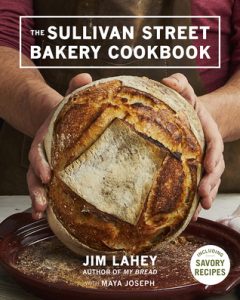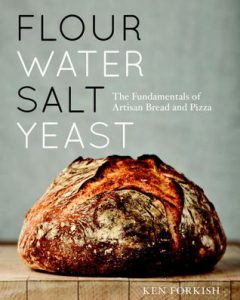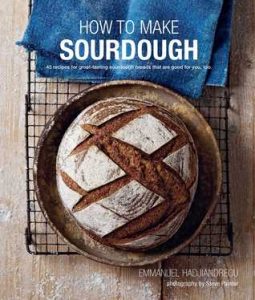 I might be a little bit late to this bandwagon, but I finally caught up and jumped right on! My absence from this said wagon was not for lack of trying, let me tell you: I’ve got two dead sourdough starters under my belt*, and so for the sake of all future sourdough cultures to be, I figured I should stop there and call it a day. This was two years ago, in the September of 2017, that this all took place, and I am proud to say that as of this year, 2019, I HAVE BECOME A SOURDOUGH MOTHER**.
I might be a little bit late to this bandwagon, but I finally caught up and jumped right on! My absence from this said wagon was not for lack of trying, let me tell you: I’ve got two dead sourdough starters under my belt*, and so for the sake of all future sourdough cultures to be, I figured I should stop there and call it a day. This was two years ago, in the September of 2017, that this all took place, and I am proud to say that as of this year, 2019, I HAVE BECOME A SOURDOUGH MOTHER**.
I have to give credit where credit’s due, because it was upon picking up The Sullivan Street Bakery Cookbook by Jim Lahey & Maya Joseph that my desire to try embarking upon the journey that is sourdough baking was reignited. And, joy of joys, the recipe included within these pages yielded me my healthy, bubbling sourdough starter son, Leviathan (hereafter referred to as Levi; sometimes spelled Levy), who dutifully lifts up my heart along with my sourdough bread. If you’d like to learn a bit more about the culture of sourdough, read on below the cut!
*Now that I have a healthy culture going, I’m pretty sure where I went wrong was not, as my friend told me, because I did not feed it the blood of my enemies – though I’m sure that would’ve worked too – but because I lacked one vital ingredient: patience.
**Not as in… having become a sourdough culture myself. I don’t know whether this is unfortunate or for the best, to be honest. See this Serious Eats article for another sourdough mother pun. I especially love this quote from the article: “Saci has been detained twice by airport police—once in New York and once in Mexico City—and questioned about the mysterious liquid he had frozen in a container in his carry on. But he and his mother were freed without incident. “I said, I am a baker, this is my mother, and it was okay. They let me keep it. I was glad because I would have been very sad to lose my mother,” he said“. And another one, a quote from Jim Lahey of The Sullivan Street Bakery Cookbook: “We rot it, portion it, form it, design it, mold it, proof it, and then bake it,” said Lahey by way of explanation. “It’s not easy. Fermentation is a moving target. It’s like life. You have to know when to fold it, know when to hold it, know when to walk away. (Yes, you can sing that last sentence.) That’s the practice of bread“. I could keep going. There are also bread puns. I love it.
 The first title that got me started on the first leg of my sourdough journey two years ago was Flour Water Salt Yeast by Ken Forkish. At that time, I had only ever made enriched breads before (and they were rather… dense, to be generous about it), so the claim that you could make artisanal bread using only 4 ingredients interested me greatly. Was it true? Just 4 ingredients? And so I devoured the first few parts of FWSY, itching to try one of the basic recipes included throughout, getting to understand the ways in which those 4 parts contributed to making bread. Forkish is incredibly detailed in this intensive yet approachable volume on sourdough starters and artisan breads, introducing the reader to breadmaking notation you’ll find elsewhere, such as hydration level and percentages, as well as covering different types of starters and how to use them (e.g. biga, poolish, etc.). In comparison, The Sullivan Street Bakery Cookbook sticks with a biga recipe, which Lahey does explain his reasons for using over a liquid starter (recipe also included for liquid starter to start off your biga).
The first title that got me started on the first leg of my sourdough journey two years ago was Flour Water Salt Yeast by Ken Forkish. At that time, I had only ever made enriched breads before (and they were rather… dense, to be generous about it), so the claim that you could make artisanal bread using only 4 ingredients interested me greatly. Was it true? Just 4 ingredients? And so I devoured the first few parts of FWSY, itching to try one of the basic recipes included throughout, getting to understand the ways in which those 4 parts contributed to making bread. Forkish is incredibly detailed in this intensive yet approachable volume on sourdough starters and artisan breads, introducing the reader to breadmaking notation you’ll find elsewhere, such as hydration level and percentages, as well as covering different types of starters and how to use them (e.g. biga, poolish, etc.). In comparison, The Sullivan Street Bakery Cookbook sticks with a biga recipe, which Lahey does explain his reasons for using over a liquid starter (recipe also included for liquid starter to start off your biga).
Yet despite all this very useful information, once it came time to put all that I learned into practice, I couldn’t get my all-purpose flour starter going. I tried once, but it started smelling stale and there was no more activity the third day, after I fed it the first time and left it for a day, so I figured I did something wrong (maybe my utensils weren’t completely clean?) and started over with a new starter. The same thing happened, and I gave up completely. What I know now, though, is that the most important ingredient is not listed on the cover, and is likely the reason my first two starters failed: PATIENCE. I cannot stress this enough. Time is arguably the most important factor in this entire process. It allows those 4 ingredients to interact with one another and ferment into the environment hospitable to the yeast & bacteria you want in your starter that will end up raising your bread and giving it the complexity of flavour you are looking for.
All this to say: I think now that I’ve exercised that patience once and seen how it brings about delightful bread that actually resembles the photos in the cookbooks, I’m ready to tackle FWSY again. I would urge anyone interested in starting off with sourdoughs to take a look through FWSY to get a better understanding of what is happening when you mix together these 4 ingredients and how they work together to create your loaf of sourdough.
 Another focused look at sourdough bread and how they affect your bread is How to Make Sourdough: 45 Recipes for Great-tasting Sourdough Breads That Are Good for You, Too by Emmanuel Hadjiandreou. This one’s all about sourdough: different sourdough starters using different flours to feed them (e.g. kamut, spelt, einkorn), and what to use those starters for (… delicious delicious bread), from basic pumperknickel sourdough and a New York-style rye sourdough to tomato & olive loaves, halloumi & mint, and many more flavour combinations. I personally prefer this volume to Artisan Sourdough by Casper André Lugg, which is similar in that its sole focus is on sourdough, though that one is also quite informative and very thorough (including a helpful troubleshooting section! I do wish it were longer and encompassed more issues a home baker might come across, but at least it had a part dedicated to troubleshooting issues).
Another focused look at sourdough bread and how they affect your bread is How to Make Sourdough: 45 Recipes for Great-tasting Sourdough Breads That Are Good for You, Too by Emmanuel Hadjiandreou. This one’s all about sourdough: different sourdough starters using different flours to feed them (e.g. kamut, spelt, einkorn), and what to use those starters for (… delicious delicious bread), from basic pumperknickel sourdough and a New York-style rye sourdough to tomato & olive loaves, halloumi & mint, and many more flavour combinations. I personally prefer this volume to Artisan Sourdough by Casper André Lugg, which is similar in that its sole focus is on sourdough, though that one is also quite informative and very thorough (including a helpful troubleshooting section! I do wish it were longer and encompassed more issues a home baker might come across, but at least it had a part dedicated to troubleshooting issues).
And if you’re looking for even more titles to look through for sourdough inspiration, take a look through my Sourdough Bibliocommons list:
And to conclude, here are some fun tidbits trawled from the web as I followed sourdough news from afar throughout the years, as well as some more recent articles and posts:
- This Serious Eats article (same one as in my ** note): Why Serious Bakers Have Mother Issues by Andrea Strong. Although I have to gripe a bit with the title, because you could be a serious baker that just doesn’t bake bread or use sourdough.
- Not that your sourdough starter needs it since these cultures are a bit hardier than we give them credit for (unless you’re going on a very long vacation, of course), but for your peace of mind, there exists a Sourdough Hotel at Stockholm’s Arlanda airport. Your mother will be fed and otherwise taken care of during its stay, and you can check in on it throughout the day if you are so inclined.
- Apparently sourdough is healthier for you than regular bread using commercial yeast: Globe and Mail, Healthline, Bread Matters, and many more, although one study referred to in The Atlantic found mixed results (the article is here, with criticism of the experiment’s design found in the comments).
I too have a dead sourdough starter under my belt, just the one so far but that’s mainly because I have yet to give it a second attempt. I love bread baking, though! It’s been several months since I’ve done it, but for a while I was baking a lot of bread at home, using grocery-store yeast, mind you. Sourdough especially captured my imagination after watching a Netflix special hosted by Michael Pollen (the author of “The Omnivore’s Dilemma” among others). It was called ‘Cooked’, I believe. I finally got my chance when a teacher gave me a small bit of his 18-year-old starter from England. I was certain I would not to let it die, determined even, but alas. I’m very interested in the first book that you mentioned! Partially as it encouraged some of your success. BRAVO!!!
Victoria, you can keep human children alive; I have faith in you that you can keep a yeast culture happy & healthy! Bread baking (with whatever yeast – I use dried yeast too!) is so satisfying, especially when you see the dough rise and smell the heavenly goodness that wafts from the loaf or the buns once it’s in the oven. I also find interacting with the dough itself incredibly soothing, whether it’s soft and pillowy like my egg, milk & butter-enriched cinnamon bread dough after it has been mixed enough, or the folding of the wet mass that is the sourdough. I’ve heard of Cooked! It’s also available as a book (https://vaughanpl.bibliocommons.com/item/show/137054130) that I’ve been meaning to read as well since I saw it. I will be putting it higher on the to-read list now that you’ve mentioned it!
P.S. I’d be more than happy to give you a part of Levi to get you started!
You are the greatest 🙂 — maybe I will take you up on that offer!
I saw that Cooked was a book, too, but only after I had watched the show (which I remember was pretty good). Very interesting stuff; Pollen is so thoughtful about food and so methodical in discovering every inch of mystery, right to the corners. It’s clear to see that he is really interested himself, and that always comes across well.